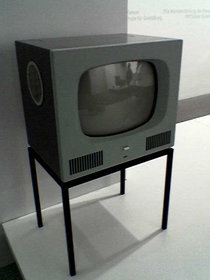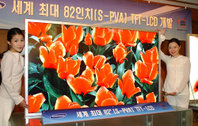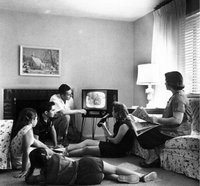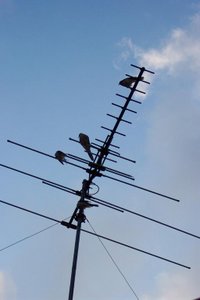History
The development of television technology can be partitioned along two lines: those developments that depended upon both mechanical and electronic principles, and those which are purely electronic. From the latter descended all modern televisions, but these would not have been possible without discoveries and insights from the mechanical systems.
The word television is a hybrid word, created from both Greek and Latin. Tele- is Greek for "far", while -vision is from the Latin visio, meaning "vision" or "sight". It is often abbreviated as TV or the telly.
Electromechanical television
The German student Paul Gottlieb Nipkow proposed and patented the first electromechanical television system in 1885. Nipkow's spinning disk design is credited with being the first television image rasterizer. However, it wasn't until 1907 that developments in amplification tube technology made the design practical. Meanwhile, Constantin Perskyi had coined the word television in a paper read to the International Electricity Congress at the International World Fair in Paris on August 25, 1900. Perskeyi's paper reviewed the existing electromechanical technologies, mentioning the work of Nipkow and others.
In 1911, Boris Rosing and his student Vladimir Kosma Zworykin achieved a television system that used a mechanical mirror-drum scanner to transmit, in Zworykin's words, "very crude images" over wires to the electronic Braun tube (cathode ray tube) in the receiver. Moving images were not possible because, in the scanner, "the sensitivity was not enough and the selenium cell was very laggy." Zworykin later went to work for RCA to build a purely electronic television, the design of which was eventually found to violate patents by Philo Taylor Farnsworth.
On March 25, 1925, Scottish inventor John Logie Baird gave a demonstration of televised silhouette images at Selfridge's Department Store in London. But if television is defined as the transmission of live, moving, half-tone (grayscale) images, and not silhouette or still images, Baird achieved this privately on October 2, 1925, and gave the world's first public demonstration of a working television system to members of the Royal Institution and a newspaper reporter on January 26, 1926 at his laboratory in London. Unlike later electronic systems with several hundred lines of resolution, Baird's vertically scanned image, using a scanning disc embedded with a double spiral of lenses, had only 30 lines, just enough to reproduce a recognizable human face.
In 1928 Baird's company (Baird Television Development Company / Cinema Television) broadcast the first transatlantic television signal, between London and New York, and the first shore to ship transmission. He also demonstrated an electromechanical colour, infrared (dubbed "Noctovision"), and stereoscopic television, using additional lenses, disks and filters. In parallel he developed a video disk recording system dubbed "Phonovision"; a number of the Phonovision recordings, dating back to 1927, still exist. In 1929 he became involved in the first experimental electromechanical television service in Germany. In 1931 he made the first live transmission, of the Epsom Derby. In 1932 he demonstrated ultra-short wave television. Baird's electromechanical system reached a peak of 240 lines of resolution on BBC television broadcasts in 1936, before being discontinued in favor of a 405 line all-electronic system.
In the U.S., Charles Francis Jenkins was able to demonstrate on June 13, 1925, the transmission of the silhouette image of a toy windmill in motion from a naval radio station to his laboratory in Washington, using a lensed disc scanner with 48 lines per picture, 16 pictures per second. AT&T's Bell Telephone Laboratories transmitted half-tone images of transparencies in May 1925. But Bell Labs gave the most dramatic demonstration of television yet on April 7, 1927, when it field tested reflected-light television systems using small-scale (2 by 2.5 inches) and large-scale (24 by 30 inches) viewing screens over a wire link from Washington to New York City, and over-the-air broadcast from Whippany, New Jersey. The subjects, which included Secretary of Commerce Herbert Hoover, were illuminated by a flying spot beam and scanned by a 50-aperture disc at 16 pictures per second.
Electronic television
Although the discoveries of Nipkow, Rosing, Baird and others were extraordinary, little of their technology is used in modern television. By 1934, all electromechanical television systems were outmoded, although electromechanical broadcasts continued on some stations until 1939.
A.A. Campbell-Swinton wrote a letter to Nature on the 18 June 1908 describing his concept of electronic television using the cathode ray tube, which had been invented in 1897 by the German physicist and Nobel prize winner Karl Ferdinand Braun. He proposed using an electron beam in both the camera and the receiver, which could be steered electronically to produce moving pictures. He lectured on the subject in 1911 and displayed circuit diagrams, but no one, including Swinton, knew how to realize the design. Although his system was never built, the cathode ray tube did come to be used to display images in almost all television sets and computer monitors until the invention of the LCD panel.
A fully electronic system was first achieved by Philo Taylor Farnsworth on September 7, 1927, although the low-resolution, light-insensitive camera tube limited the image to a plate of glass painted black, with a straight line etched across it, rotated in front of a bright carbon arc lamp. Seven years later, on August 25, 1934, at the Franklin Institute in Philadelphia, Farnsworth gave the world's first public demonstration of a working, all-electronic television system, with 220 lines per picture, 30 pictures per second. Over a three week period, vaudeville acts, athletic and sports demonstrations, politicians, and hundreds of ordinary citizens were captured on Farnsworth's cameras in the open air and simultaneously shown on his receiving sets.
Read more at Wikipedia.org





